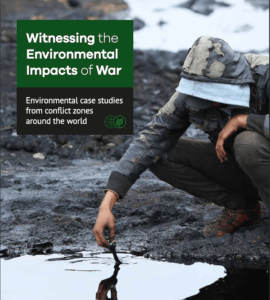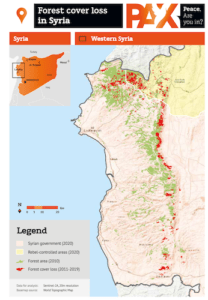 by Peace House staff
by Peace House staff
Armed conflicts create tremendous harm on the natural environment. Conversely damaged landscapes and ecosystems create conditions ripe for new wars. A terrible, sad, and ugly cycle. Notions that we can restore functioning ecosystems after war-related disasters may be achievable — but only after we acknowledge the tremendous harm already done (and underway).
A 2020 report titled “Witnessing the Environmental Impacts of War,” produced by a consortium of international groups who conducted original research on the subject highlights six regions. The report summarizes that in Syria, where a stifled revolution has endured a decade under the Assad regime in something short of a proxy war between superpowers, the fighting has led to a 20 percent reduction in tree cover in forested regions in the Northeast. Researchers used a combination of satellite imagery and boots on the ground to provide assessments, and a potential path for postwar restoration alternatives.
“New tools and technologies like those monitoring agricultural stresses in Yemen or deforestation and pollution in Syria enable identification of issues for post-conflict attention. And in areas where the fighting has stopped, efforts to protect the environment from future harm while clearing the explosive legacy of conflict offer an opportunity to address the twin threats of unexploded ordnance and non-biodegradable wastes. There is also hope, as communities come together to protect water and build a lasting and resilient peace.”



